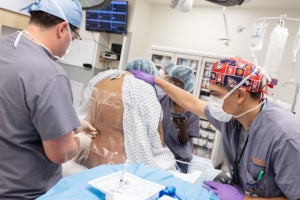A Day in Obstetrics
Obstetric Anesthesia at UVA
Updated description provided by Matt Cross, Class of 2022

Three residents share the responsibility and privilege of providing obstetric anesthesia over a four week period at UVA. The basic outline of the schedule divides between weekdays and weekends. During the week, two residents alternate working a short and long shift, 7am to 1pm and 7am to 7pm respectively, while the third resident covers the night shift from 7pm to 7am. Friday and Saturday are covered by 24 hour resident shifts, and the Sunday 24 hour shift is covered by a CRNA.
Residents do one month of OB anesthesia in both their CA-1 and CA-2 year. During the CA-3 year, residents will typically rotate for 1 or two weeks on OB anesthesia at UVA and then have the option of working 3 weeks at Fairfax Hospital in Northern Virginia (our only rotation in a different hospital). Most senior residents elect the Fairfax rotation, as it is a high-volume center that helps them fine tune their neuraxial procedural skills.
Described below are the events of a long day shift from a rotation on OB.
One long day shift
0645: Clay, Emmarie, and I meet a few minutes before 7 am to make sure the two OB operating rooms are set for the day and to go over the current list of patients on the labor and delivery unit. Clay,, our night resident, kept busy overnight with a pair of c-sections and a labor epidural that is still running.
0730: Emmarie and I meet with the OB residents to discuss the current list of patients and their anticipated anesthesia needs. They would like to perform one c-section and feel that another patient would benefit from a labor epidural. The short resident generally will take on the first C-section, so Emmarie goes to meet that patient. This is her first pregnancy and she is lucky enough to have twins; however, the first twin is in a breech position. She is otherwise healthy and her labor has just started. She presents the patient to Sachin and suggests we perform a spinal anesthetic. He agrees to the plan and we discuss implications of twin-pregnancy on neuraxial anesthesia, including the risk for exaggerated hypotension. While she and Sachin have been discussing, I’ve prepped the laboring patient for the epidural, which goes smoothly.
0830: I run to the OR to help Emmarie position the patient in the OB OR for a spinal anesthetic, which she places on the first stick. The patient tolerates the spinal block well hemodynamically, and after ensuring a T4 sensory level, the C-section is underway.
1100: Two new patients arrive on L&D during the c-section. I meet and consent them for epidurals if desired later. The C-section wraps up, and Emmarie departs for the main operating rooms to help out with a few lunch breaks before heading home at 1pm. I go and see all the patients who delivered yesterday to make sure they don’t have any residual neurologic symptoms after their surgeries, then write quick post-anesthetic notes on all of them. This only takes about 20 minutes in total, and I then head back to the floor.
1400: After about two hours of a very quiet OB floor (I used the time to do some practice questions for the upcoming ITE exam), one of the patients I met earlier is requesting a labor epidural. She is a multiparous patient and has already advanced to 7cm dilation. She appears in considerable discomfort and we decide to perform a combined spinal-epidural. Within minutes her pain begins to subside from the spinal component. After starting the epidural infusion, I return in an hour to assess the sensory spread of the epidural catheter. She is still comfortable and it is not too much longer until she delivers.
1800: The OB resident calls to ask for an urgent c-section for fetal decels on an antepartum patient. I’ve previously met the patient, but go to reassess her and discuss options for anesthesia. She is amenable to a spinal anesthetic. The OB nurses help to get her back to the operating room and the procedure is soon underway.
1900: Clay arrives to start the night shift and take over for the c-section. I sign out to him the rest of the patients on the floor, and go home to look forward to my short day tomorrow.
updated 2020
